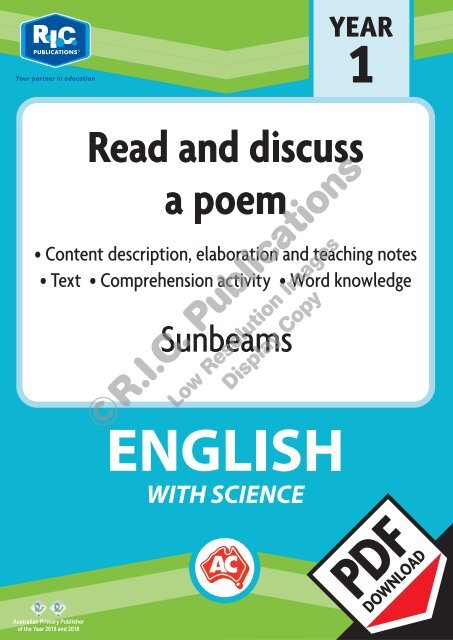RIC-30015 Sunbeams - Read and discuss a poem
You also want an ePaper? Increase the reach of your titles
YUMPU automatically turns print PDFs into web optimized ePapers that Google loves.
©R.I.C. Publications<br />
Low Resolution Images<br />
Display Copy
<strong>Sunbeams</strong><br />
• • • • • • • • • • • • • • • • • • • • • • • • •<br />
Teacher information<br />
Curriculum links<br />
J<br />
Activity Content description Elaboration<br />
Text • <strong>Read</strong> decodable <strong>and</strong> predictable texts using developing phrasing, fluency, contextual, • <strong>Read</strong>s a <strong>poem</strong><br />
semantic, grammatical <strong>and</strong> phonic knowledge <strong>and</strong> emerging text processing strategies, for • Recognises rhyming words<br />
example prediction, monitoring meaning <strong>and</strong> re-reading (ACELY1659J C,<br />
• Listen to, recite <strong>and</strong> perform <strong>poem</strong>s, chants, rhymes <strong>and</strong> songs, imitating <strong>and</strong> inventing<br />
sound patterns including alliteration <strong>and</strong> rhyme (ACB.T1585) C,<br />
• Respond to texts drawn from a range of cultures <strong>and</strong> experiences (ACELY1655) C,<br />
• Engage in conversations <strong>and</strong> <strong>discuss</strong>ions, using active listening behaviours, showing<br />
interest, <strong>and</strong> contributing ideas, information <strong>and</strong> questions (ACELY1656) C,<br />
Comprehension • Use comprehension strategies to build literal <strong>and</strong> inferred meaning about key events, • Discusses vocabulary from a <strong>poem</strong><br />
ideas <strong>and</strong> information in texts that they listen to, view <strong>and</strong> read by drawing on growing • Answers questions about a <strong>poem</strong><br />
knowledge of context, text structures <strong>and</strong> language features (ACB.Y1660) C,<br />
'-<br />
Word knowledge<br />
Additional teacher<br />
information<br />
• Recognise <strong>and</strong> know how to use simple grammatical morphemes to create word families<br />
(ACB.A1455) G<br />
• Underst<strong>and</strong> that a letter can represent more than one sound <strong>and</strong> that a syllable must<br />
contain a vowel sound (ACELA1459) C,<br />
• Use short vowels, common long vowels, consonant digraphs <strong>and</strong> consonant blends when<br />
writing, <strong>and</strong> blend these to read single syllable words (ACELA1458) C,<br />
Definition of terms<br />
Text<br />
A book or other written or printed work, regarded in terms of its<br />
content rather than its physical form.<br />
Poem<br />
A piece of writing in which the expression of feelings <strong>and</strong> ideas<br />
is given intensity by particular attention to diction (sometimes<br />
involving rhyme), rhythm <strong>and</strong> imagery.<br />
Diagram<br />
A simplified drawing showing the appearance, structure or<br />
workings of something; a schematic representation.<br />
• Science<br />
Links to other curriculum areas<br />
- Observable changes occur in the sky <strong>and</strong> l<strong>and</strong>scape<br />
(ACSSU019)<br />
G<br />
• Adds '-s' to make plural nouns<br />
• <strong>Read</strong>s words with 'ur' such as 'returns'<br />
• Adds '-er' <strong>and</strong> '-est' to adjectives<br />
Terminology for students<br />
<strong>poem</strong><br />
word<br />
sentence<br />
text<br />
title<br />
rhyme<br />
adjective<br />
©R.I.C. Publications<br />
Low Resolution Images<br />
Display Copy<br />
Suggested reading<br />
• Day <strong>and</strong> night <strong>and</strong> Seasons of the year (Patterns in nature<br />
series) by Margaret Hall<br />
• I am afraid of the dark (Good night books, Ages 2-6. The<br />
adventures of Robin <strong>and</strong> Sunbeam series, ebook 1) [Kindle<br />
Edition] by Mira Drori<br />
1 • · • • • • • • Developing comprehension skills <strong>and</strong> word knowledge (Year 1) • • • • • • R.I.C. Publications ® · • • • • www.ricpublications.com.au
Teaching notes<br />
J<br />
Text<br />
Comprehension<br />
Teacher information<br />
Teacher information<br />
• This <strong>poem</strong> is about the effect sunbeams have on people <strong>and</strong><br />
places.<br />
Introduction<br />
• Discuss the importance of the sun. Elicit from students the role<br />
they think the sun plays for us on Earth. <strong>Read</strong> Day <strong>and</strong> night <strong>and</strong><br />
Seasons of the year by Margaret Hall to stimulate thought <strong>and</strong><br />
<strong>discuss</strong>ion.<br />
Development<br />
• <strong>Read</strong> <strong>and</strong> <strong>discuss</strong> the <strong>poem</strong> with the students. Assist them with<br />
any unfamiliar words.<br />
• Question students to gauge their underst<strong>and</strong>ing of what they<br />
have listened to or read.<br />
• While reading, observe how the students use phonic skills<br />
<strong>and</strong> knowledge to decode words. Assist them to decode more<br />
difficult words.<br />
• Emphasise rhyming words during reading. If reading the text<br />
together as a class, correct inaccurate reading.<br />
Differentiated individual/paired/group work<br />
• In pairs, have students ask each other to find a matching<br />
rhyming word in the <strong>poem</strong>. For example, Partner A asks Partner<br />
B to find a rhyming word for 'goes' ('toes'). They then work<br />
together to think of more words that rhyme with those two.<br />
Partner B then chooses another word from the <strong>poem</strong> <strong>and</strong> they<br />
continue in this way.<br />
• Challenge capable readers to find five words with one syllable<br />
<strong>and</strong> five words with more than one syllable. They should make<br />
a list of these words.<br />
• Less capable readers may need help with the <strong>poem</strong> so the<br />
teacher could work with a small group, working on each stanza<br />
in detail, providing reading practice <strong>and</strong> support.<br />
Review<br />
• As a class, <strong>discuss</strong> the rhyming words that the pairs discovered.<br />
Discuss the spelling patterns that can be seen in rhyming<br />
words.<br />
• Questions will involve personal responses from the students.<br />
Introduction<br />
• The students can <strong>discuss</strong> what they remember reading in the<br />
<strong>poem</strong>. Can they recall what happens at night? What happens<br />
in summer? What happens in winter? Ask the students to recall<br />
some rhyming words.<br />
Development<br />
• Discuss the comprehension activities on page 92, then allow<br />
the students to complete the page independently.<br />
• Compare <strong>and</strong> <strong>discuss</strong> the students' answers to Questions 7<br />
<strong>and</strong> 8.<br />
Differentiated individual/paired/group work<br />
• In groups, ask the students to think about their favourite<br />
seasons. Each group must think of five reasons why the<br />
chosen season is the best season. They should illustrate their<br />
responses.<br />
Review<br />
• As a class, listen to the students read about their favourite<br />
seasons. Discuss any questions they found difficult to answer<br />
or perhaps answered incorrectly.<br />
©R.I.C. Publications<br />
Low Resolution Images<br />
Display Copy<br />
R.I.C. Publications ® • • • • • • • www.ricpublications.com.au • • • • • • • Developing comprehension skills <strong>and</strong> word knowledge (Year 1) • • • • • • 2
Teaching notes<br />
(continued)<br />
Answers<br />
J<br />
Teacher information<br />
Word knowledge<br />
• The activities on page 93 focus on rhyming words, adding 's' to<br />
make plural words, adding '-er' <strong>and</strong> '-est' to words, words with<br />
'ur' as in 'turn', <strong>and</strong> identifying the suffix 'y' in cloudy.<br />
Introduction<br />
• Re-read the text, explaining to the students that the focus will<br />
be on words. While reading, ask the students to underline the<br />
word 'sunbeam' every time it is mentioned (seven times).<br />
Development<br />
• Discuss again the rhyming words that are found in the <strong>poem</strong>.<br />
Ensure that students can see the rhyming part of each word.<br />
• Revise singular <strong>and</strong> plural words.<br />
• Students have had considerable practice adding '-er' <strong>and</strong> '-est'<br />
to words. Revise what they remember about adding these, <strong>and</strong><br />
the term 'suffix'.<br />
• Discuss the 'ur' in returns. Emphasise the sound these two<br />
letters make. Can students think of other words that have this<br />
sound? Make a list on the board.<br />
• Discuss the word knowledge activities on page 93, then allow<br />
the students to complete the page independently.<br />
Differentiated individual/paired/group work<br />
• In pairs, students can be asked to create a <strong>poem</strong> of their own<br />
using some of the rhyming words they have encountered in this<br />
unit. The <strong>poem</strong>s can be very short in length.<br />
• Ask the students to place the words in Question 6 into<br />
sentences.<br />
Review<br />
• As a class, invite some of the pairs to read out the <strong>poem</strong>s they<br />
have written. The students can say why they like particular<br />
<strong>poem</strong>s.<br />
Comprehension<br />
1. under a tree<br />
2. (a) fade away (b) summer<br />
3. Answers may include:<br />
It is dark. There is no light.<br />
4. Answers will vary.<br />
5. The s<strong>and</strong> feels warm.<br />
6. (a) returns (b) rest<br />
7. Answers may include:<br />
It would be dark/cold.<br />
Things wouldn't grow.<br />
8. Answers will vary.<br />
Wont knowledge<br />
1. bee - tree, sea, me<br />
goes - nose, toes<br />
play - way, away<br />
bend - friend, end<br />
2. (a) toes (b) noses (c) nights (d) friends<br />
3. -y<br />
4.<br />
(a) lighter (b) darker (c) longer (d) warmer<br />
5. (a) darkest (b) brightest<br />
6. (a) hurt (b) church (c) burst<br />
(d) Thursday (e) nurse (n purple<br />
7. (a) nurse (b) Thursday (c) purple (d) church<br />
©R.I.C. Publications<br />
Low Resolution Images<br />
Display Copy<br />
3 • · • • • • • • Developing comprehension skills <strong>and</strong> word knowledge (Year 1) • • • • • • R.I.C. Publications ® · • • • • www.ricpublications.com.au
<strong>Sunbeams</strong> -1<br />
<strong>Read</strong> the <strong>poem</strong>.<br />
<strong>Sunbeams</strong> dance upon the sea<br />
And make it sparkle<br />
Just for me.<br />
<strong>Sunbeams</strong> softly kiss my nose<br />
And warm the s<strong>and</strong><br />
Beneath my toes.<br />
<strong>Sunbeams</strong> shine to light the way<br />
then night returns<br />
And they fade away.<br />
©R.I.C. Publications<br />
Low Resolution Images<br />
Display Copy<br />
I like sunbeams, they are my friend.<br />
They make me smile<br />
When dark clouds end.<br />
So here I rest, beneath this tree,<br />
And write this <strong>poem</strong><br />
About sunbeams <strong>and</strong> me.<br />
My learning log When I read this <strong>poem</strong>, I could read: 0 all of it. 0 most of it. 0 parts of it.<br />
R.I.C. Publications ® • • • • • • • www.ricpublications.com.au • • • • • • • Developing comprehension skills <strong>and</strong> word knowledge (Year 1) • • • • • 4
<strong>Sunbeams</strong> - 2<br />
Comprehension<br />
1. Where was the poet sitting<br />
while •writing• this <strong>poem</strong>.<br />
2. Write words to finish the sentences.<br />
(a) When night comes the sunbeams<br />
<br />
.,iv;..<br />
..,..,_<br />
<br />
<br />
.:r'ir.,ivr;.. ""'- <br />
<br />
(b) More sunbeams shine on the earth in __________ _<br />
seasons.<br />
3. Why can't sunbeams be seen at night? ____________ _<br />
4. Write a new title for the text.<br />
5. How do you know the poet isn't wearing shoes?<br />
6. Write words from the <strong>poem</strong> that rhyme with each word.<br />
(a) burns _______ _<br />
7. What would happen if the sun stopped shining?<br />
<br />
(b) best ______ _<br />
©R.I.C. Publications<br />
Low Resolution Images<br />
Display Copy<br />
8. Which season do you like best? ______________ _<br />
Why? _____________________ _<br />
My learning log<br />
While doing these activities:<br />
I found a __ easy. I I found a __ tricky. I I found a __ fun.<br />
5 • • • • • • • • Developing comprehension skills <strong>and</strong> word knowledge (Year 1) • • • • • • R.I.C. Publications ® · • • • • www.ricpublications.com.au
<strong>Sunbeams</strong> - 3<br />
1. Find the rhyming words in the <strong>poem</strong> for the following words.<br />
bee goes play bend<br />
Word knowledge<br />
\..<br />
2. Add 1 s 1 to make 'more than one'.<br />
(a) toe (b) nose<br />
(c) night (d) friend<br />
3. What has been added to 'cloud' to make<br />
the adjective 'cloudy'?<br />
4. Add the suffix '-er' to make adjectives.<br />
(a) light (b) dark<br />
(c) long (d) warm<br />
5. Add the suffix '-est' to make adjectives.<br />
(a) dark<br />
(b) bright<br />
6. Write 'ur' like in 'returns' into these words. <strong>Read</strong> them.<br />
©R.I.C. Publications<br />
Low Resolution Images<br />
Display Copy<br />
(a) h t (b) ch ch (c) b st<br />
{d) Th sday (e) n se (f) p pie<br />
7. <strong>Read</strong> the clues <strong>and</strong> write the 'ur' word.<br />
(a) Someone who works in a hospital. _________<br />
(b) A day of the week, but not Saturday. ________<br />
(c) A colour. ________<br />
(d) A place where people pray <strong>and</strong> sing. ________<br />
I know what a plural is.<br />
My learning log Colour:<br />
I can read words like church, purple <strong>and</strong> nurse.<br />
R.I.C. Publications ® • • • • • • • www.ricpublications.com.au • • • • • • • Developing comprehension skills <strong>and</strong> word knowledge (Year 1) • • • • • • 6


















